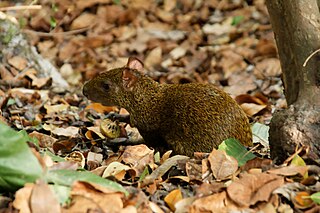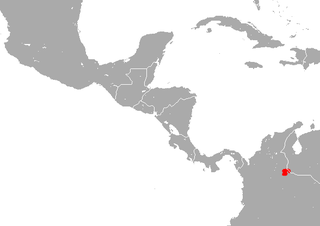
Dasyproctidae is a family of large South American rodents, comprising the agoutis and acouchis. Their fur is a reddish or dark colour above, with a paler underside. They are herbivorous, often feeding on ripe fruit that falls from trees. They live in burrows, and, like squirrels, will bury some of their food for later use.

The lowland paca, also known as the spotted paca, is a large rodent found in tropical and sub-tropical America, from east-central Mexico to northern Argentina, and has been introduced to Cuba and Algeria.

The agouti or common agouti is any of several rodent species of the genus Dasyprocta. They are native to Middle America, northern and central South America, and the southern Lesser Antilles. Some species have also been introduced elsewhere in the West Indies. They are related to guinea pigs and look quite similar, but they are larger and have longer legs. The species vary considerably in colour, being brown, reddish, dull orange, greyish, or blackish, but typically with lighter underparts. Their bodies are covered with coarse hair, which is raised when alarmed. They weigh 2.4–6 kg (5.3–13.2 lb) and are 40.5–76 cm (15.9–29.9 in) in length, with short, hairless tails.

The black agouti is a South American species of agouti from the family Dasyproctidae.

The red-rumped agouti, also known as the golden-rumped agouti, orange-rumped agouti or Brazilian agouti, is a species of agouti from the family Dasyproctidae.

Azara's agouti is an agouti species from the family Dasyproctidae. Found in Brazil, Paraguay, and Argentina, it is named after Spanish naturalist Félix de Azara. The population is unknown and may have gone locally extinct in some areas due to hunting; it is listed as vulnerable in Argentina.

The black-rumped agouti is an agouti species from the family Dasyproctidae. It is endemic to Brazil, and its range roughly equals the Northeast Region. It is named after its black rump which contrasts clearly with the orange body.

The Central American agouti is a species of agouti from the family Dasyproctidae. The main portion of its range is from Chiapas and the Yucatan Peninsula, through Central America, to northwestern Ecuador, Colombia and far western Venezuela. A highly disjunct population is found in southeastern Peru, far southwestern Brazil, Bolivia, western Paraguay and far northwestern Argentina. The disjunct population has been treated as a separate species, the brown agouti, but a major review of the geographic variation is necessary. The Central American agouti has also been introduced to Cuba and the Cayman Islands.

The Coiban agouti is a species of rodent in the family Dasyproctidae. It is endemic to the island of Coiba (Panama) and resembles the more widespread Central American agouti. It is threatened by habitat loss.
The crested agouti is a species of rodent in the family Dasyproctidae. It is endemic to Guyana and Suriname. Its taxonomic status is uncertain and it may be synonymous with Dasyprocta leporina, leading the IUCN to rate it as Data Deficient.
Kalinowski's agouti is a species of rodent in the family Dasyproctidae. It is endemic to southeast Peru. It occurs at elevations of up to 3,080 metres (10,100 ft) asl. It is threatened by habitat loss.

The Mexican agouti, also known as the Mexican black agouti, is a species of rodent in the family Dasyproctidae. It is native to lowland evergreen forest and second growth in southern Mexico, but has also been introduced to Cuba. This critically endangered species is threatened by habitat loss. Its overall blackish color separates it from the only other agouti found in Mexico, the Central American agouti.

The Ruatan Island agouti, also called the Roatán Island agouti, is a species of agouti in the family Dasyproctidae.
Serra da Cutia National Park is a national park in the state of Rondônia, Brazil.
Nephelomys caracolus, also known as the Costa Central oryzomys or caracol rice rat, is a species of rodent in the genus Nephelomys of family Cricetidae. It is found in cloud forest in the Cordillera de la Costa Central of Aragua, Miranda, and the Distrito Federal in north-central Venezuela at elevations from 1000 to 2500 m. It is nocturnal and terrestrial, and has a varied diet. In most Nephelomys species, the posterolateral palatal pits, perforations of the palate near the third molar, are conspicuous and receded into a fossa, but in N. caracolus and the Ecuadorian species N. nimbosus, the pits are much smaller.

The Tamá small-eared shrew is a species of mammal in the family Soricidae. It is known from the Cordillera Oriental of Colombia and the Páramo de Tamá of western Venezuela, where it has been found primarily in cloud forest at elevations between 2380 and 3330 m. Its range includes Venezuela's El Tamá National Park. The closest relatives of the species are C. meridensis and C. thomasi.












